Air resistance is a frictional force that air pushes against a moving object.
Do you remember how difficult to walk against the wind? Air resistance produce by the wind always pushes you back. On the other hand walking with the wind always help you walk faster, because there is no air resistance.
You know, walking through air is easier than walking through water. But, air resists movement too. Let’s see what air resistance is and how air resistance works with this lesson, Air Resistance.
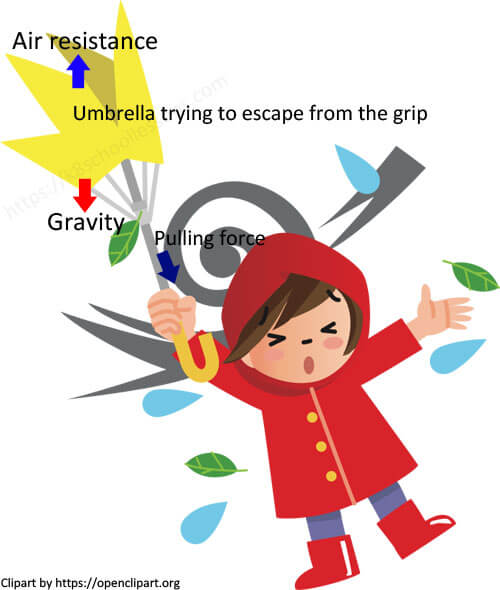
It is difficult to hold on to the umbrella on a windy day
Air resistance is a frictional force that air pushes against a moving object.
It is also known as drag.
Air resistance always tries to slows a moving object down.
The faster you move, the greater the resistance.
For example;
The faster the vehicle -moves, the bigger the air resistance becomes.
Like friction, air resistance acts in the opposite direction to the movement of the object.
(Read the lesson ‘Friction‘)
Let’s learn some examples of air resistance with this lesson, Air Resistance.


Air resists the movement causing the parachute to fall slowly
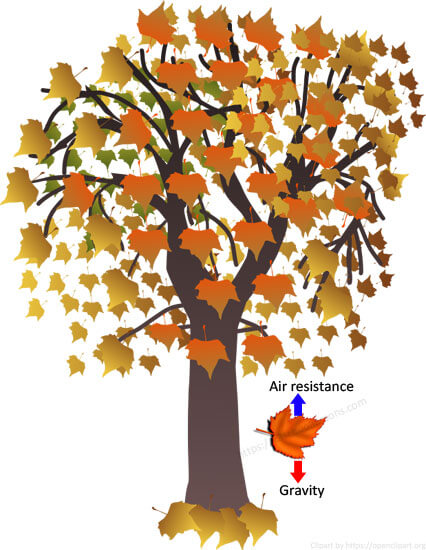
A leaf fallen off a tree gently floats down to the ground

Why do the leaves fallen off trees float all over the place on windy days?

Light objects float all over the area on windy days
For Example;
You might have experienced how difficult it was to hold on to your umbrella on a windy day

It is difficult to hold on to the umbrella on a windy day
As you keep pedalling, bicycle doesn’t keep going faster and faster. This is because it reaches a steady top speed. Then you have to continue pedalling just to keep it going at that speed. You are using a force without changing the bicycle’s speed.
This happens due to ‘friction’. There are two types of friction hold you back when you are cycling.
These frictional forces get bigger the faster you go.
You have to push your way through the air to cycle. This sets up the friction, air resistance.
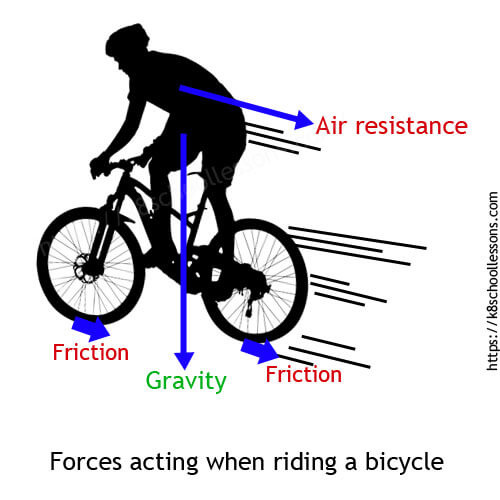
Forces acting on you and the bicycle when riding a bicycle
The faster you go, the bigger the air resistance
For example;
When a bicycle’s speed doubles, air resistance increases four times.
At low speed, the friction is small, much smaller than the force pushing the bicycle forward. And so most of the force which you put on the pedal goes towards speeding up the bicycle.
But, as the bicycle speeds up, friction increases. Eventually, it gets so large that it is equal to the force pushing the bicycle forward. All your force is used to overcome friction. The two forces are balanced (equal and opposite). The bicycle keeps going at a steady speed.
Air resistance is used by parachutists to slow down their fall.

Air resistance helps parachutist to slow down his fall
The open parachute has a very large surface area.
The bigger the surface area, the greater the resistance.
So the open parachute makes a lot of air resistance. This slows the parachute down and the parachutist drops gently to the ground.
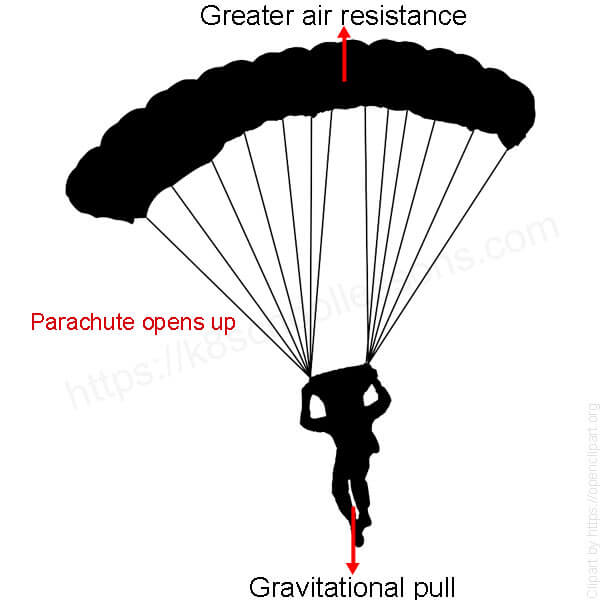
Open parachute makes a lot of air resistance
A space shuttle uses a parachute to slow it down quickly when it lands. This means that it can land on a shorter runaway.
Gravity that is acting on light objects, like feathers, is not very strong to pull them towards the centre of the earth quickly. Besides, the air is all over the place. So, there is a lot of air resistance and that resistance makes light objects fall slower.

Air resistance makes light objects fall slower making them float for a while
For example;
When a feather falls, it falls slowly because the air is in its way.
If you dropped a feather and a golf ball at the same time in a vacuum (space with no air), the feather would drop as fast as the golf ball.
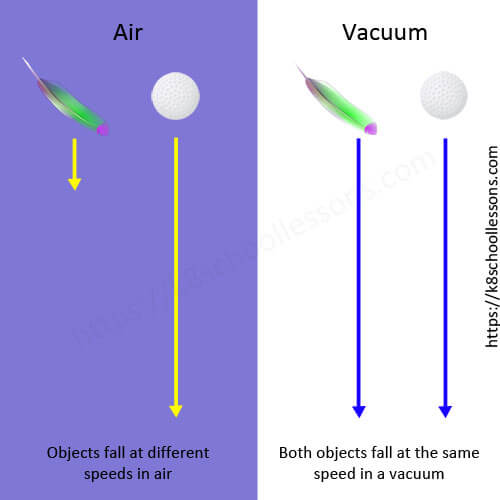
Light objects fall slowly because the air is in its way
??? On a windy day in Autumn, have you seen the beautiful orange or red maple leaves floating all over the place, trying so hard to touch the ground??
When a leaf falls from a tree, it floats gently down to the ground. Air resistance pushes up against the surface of the leaf. The bigger the surface area, the greater the resistance. A leaf is so light the pull of gravity is not much stronger than the upward force of the air resistance. So the leaf falls slowly.
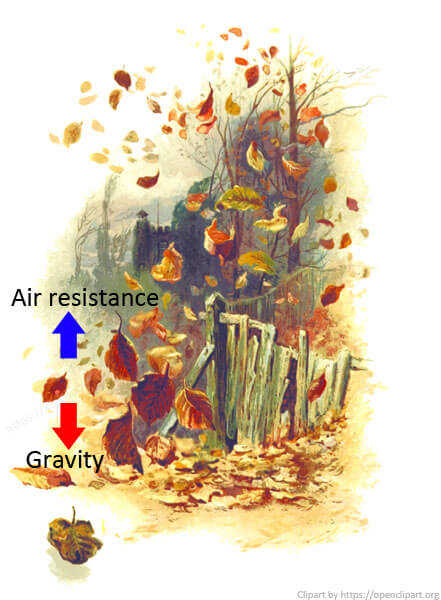
A leaf is so light the pull of gravity is not much stronger than the upward force of the air resistance
There are four main forces acting on an airplane.
(Also, read ‘Forces and Motion‘)
Air resistance and gravity are the two inbuilt forces of nature which act on anything lifted from the earth and moved through the air.
Thrust and Lift are created artificially to overcome air resistance and gravity in order to enable an airplane to fly.
The engine and propeller combination is designed to produce thrust to overcome air resistance (drag).
The wing is designed to produce lift to overcome gravity, also called weight.
 Forces on an Airplane
Forces on an Airplane
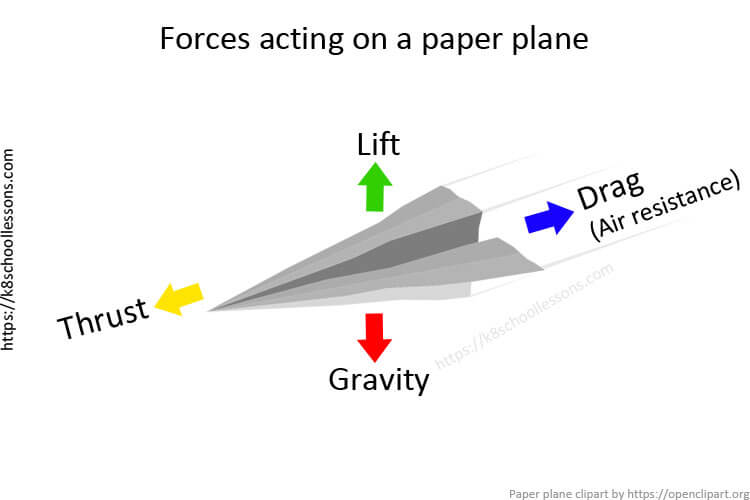 Forces on a Paper Plane
Forces on a Paper Plane
In order for things to move efficiently through air or water, they need to have the smallest possible surface area. This is because, The bigger the surface area, the greater the resistance. Therefore, things need to be streamlined to push against the air or water.
For example;
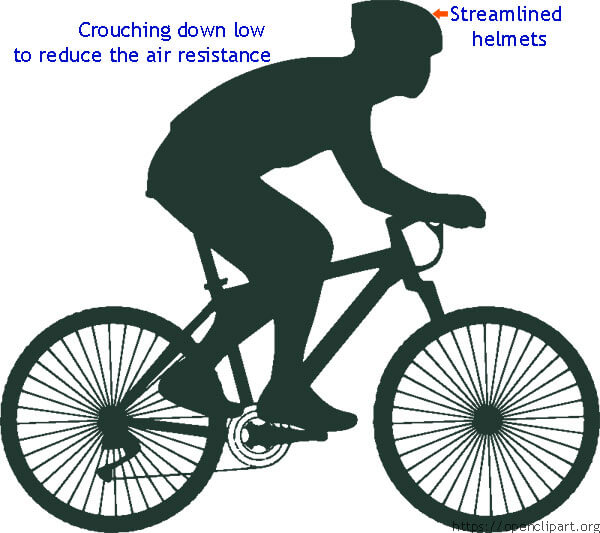
Crouching down low on the bikes helps racing cyclists to reduce the air resistance
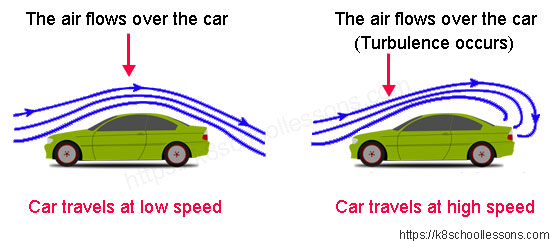
Car designers see which shapes cut through the air best

Modern shapes of cars which can cut through the air best

Lorries use spoilers or wind deflectors to help the air flow more smoothly
Water resistance is stronger than air resistance. Animals that move fast through the water need to be streamlined. This is why fish are all well streamlined. Their smooth, round heads and long, tapering bodies let the water flow past them more easily.
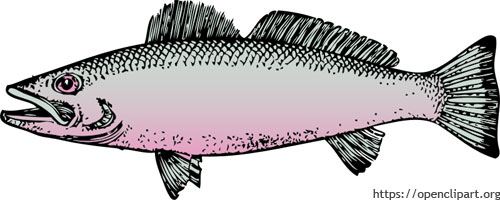
Long, tapering streamlined body shape of a fish
For example;

Thanks to the streamlined shape of the body, dolphins can swim quickly through the water

The streamlined shape of a submarine helps the submarine to move faster through the water
Do spacecraft need to be streamlined like submarines?
There are no particles of air or water in space. So, there is no resistance in space. Therefore, spacecraft flying in space do not need to have streamlined shape.This is why many bulky things such as aerials, antennae, solar panels etc. are attached to many satellites and spacecraft.

Spacecrafts do not need to have streamlined shape
Hope you learn a lot about air resistance with the lesson ‘Air Resistance’.